
La instalación del a jdk en servidores Unix puede generar a veces algunos problemas ya que generalmente no hay una guía exacta para realizar la instalación, pero desde mi punto de vista creo que también se debe a que en internet hay muchas formas de hacerlo y también es verdad que Unix lo permite, por lo tanto no hay una forma «correcta» de hacerlo.
Sin embargo hay una forma de mantener un orden dentro de todo este caos, por ejemplo hay servidores que a veces necesitan tener instaladas dos o más versiones de la jdk en el mismo server… y ¿como controlamos esto? este tipo de cuestiones son las que causan esos problemas a los que me refiero porque muchos ajustamos variables de entorno y terminamos creando un dessatre, y bueno antes de mostrar la instalación quería transmitir esta pequeña perspectiva.
El siguiente comando es el que nos a ayudar en Suse a controlar esto:
update-alternatives
Nota: en Ubuntu el equivalente es el comando alternatives
Seguir leyendo →




